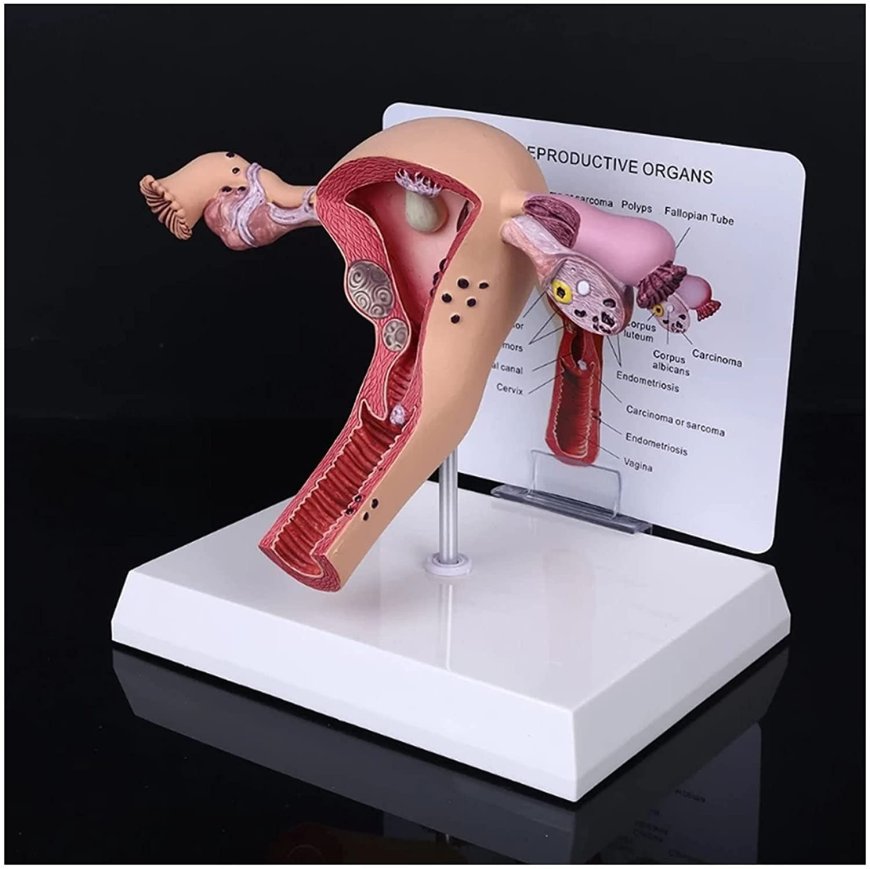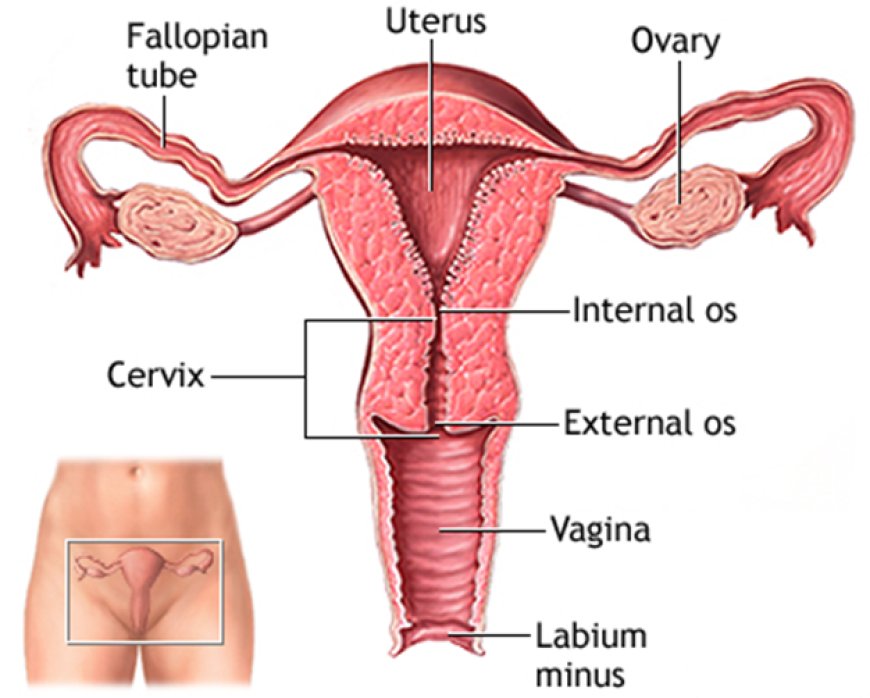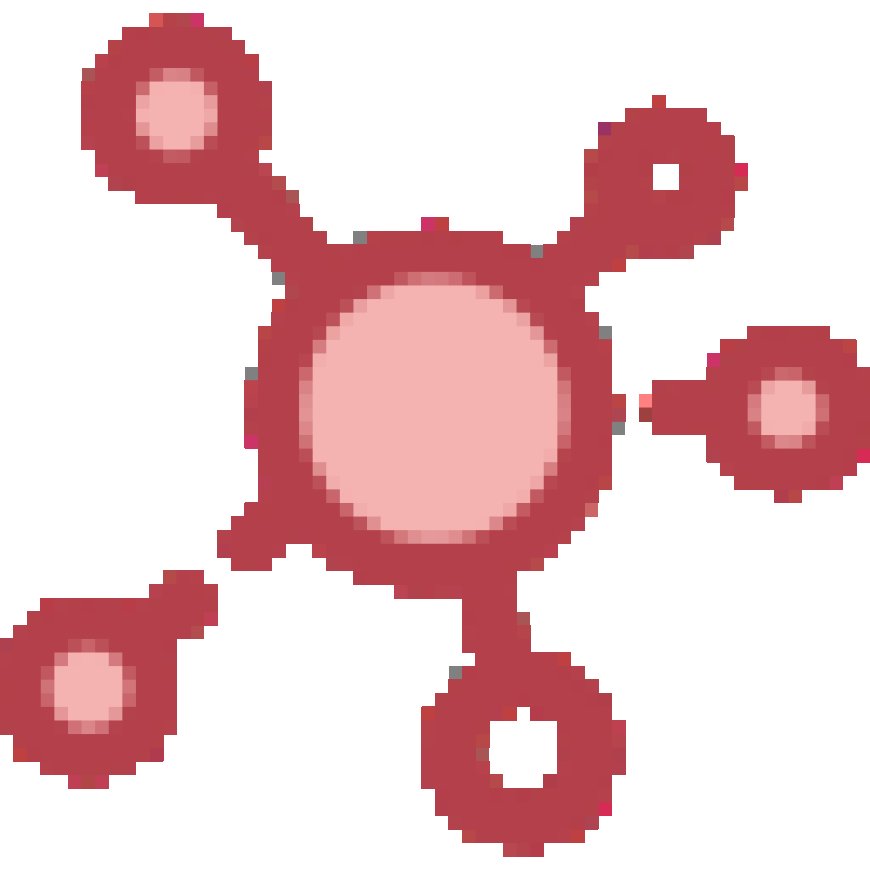Definition of uterus, Anatomy, Function, Size, Position & Conditions
The uterus is a pear shaped organ that is an essential part of the female reproductive system. Located in the pelvis, it is where a fertilized egg implants and grows during pregnancy.

Uterus
The uterus is a pear shaped organ that is an essential part of the female reproductive system. Located in the pelvis, it is where a fertilized egg implants and grows during pregnancy. The uterus is composed of several layers, including an inner lining called the endometrium, which thickens in preparation for pregnancy, and an outer layer of muscle fibers that contract to help push the baby out during labor. The uterus is able to undergo significant changes over the course of a woman's lifetime, expanding and contracting over the menstrual cycle and adapting to support the growing fetus during pregnancy. It is a remarkable and complex organ that plays a vital role in the reproductive and hormonal health of the female body.
 Overview
Overview
What is a uterus?
The uterus, also known as the womb, is a muscular organ located in the female pelvis between the bladder and rectum. The uterus is where a fertilized egg implants and is also responsible for contracting during labor to aid in delivery. The uterus is made up of several layers, including the inner lining called the endometrium, which thickens each month for the potential implantation of a fertilized egg. The cervix, which is the lower narrow part of the uterus, connects the uterus to the vagina. The uterus plays a crucial role in the reproductive health of women .
![]()
Function
What does a uterus do?
Your uterus plays a key role in your reproductive health and function. The uterus, also known as the womb, performs a variety of important functions in the female reproductive system. It is a hollow, muscular organ located in the pelvis that is responsible for hosting the growth and development of a fetus during pregnancy. The uterus plays a crucial role in the menstrual cycle by growing and shedding the endometrial lining. The cervix, which is located at the bottom of the uterus, also allows for the flow of menstrual blood and provides a pathway for sperm to enter the uterus. During sexual intercourse, the uterus can contract, which can create sensations of pleasure. After childbirth, the uterus contracts to expel the placenta and to shrink back to its pre-pregnancy size. The uterus is a complex and essential organ for the female reproductive system and can impact overall health and well being. It is important for women to receive proper medical care and monitoring of the uterus throughout their lifetime.

 Anatomy
Anatomy
What does a uterus look like?
Your uterus looks like a pear or light bulb. It’s about the size of your fist. It’s also commonly described as an upside-down pear. Your uterus has two horn-like organs at the top (the fallopian tubes). It connects to your cervix at the bottom, which is the part that opens (dilates) during vaginal delivery.
Your uterus has several sections :-
1. Fundus :- The uppermost and widest part of your uterus. It connects to your fallopian tubes.
2. Corpus :- The main body of your uterus. This is where a fertilized egg implants during pregnancy.
3. Isthmus :- The part of your uterus between your corpus and cervix. It’s where your uterus starts to narrow or thin.
4. Cervix :- The lowest part of your uterus. Your cervix opens to your vagina.

Where is the uterus in your body?
Your uterus is in your pelvis between your bladder and rectum. It’s supported by your pelvic floor muscles and perineal body. Ligaments in your pelvis, lower back and hips also help hold your uterus in place.
What is your uterus made of ?
Your uterus consists of three layers:
1. Perimetrium :- The outermost, protective layer.
2. Myometrium :- The highly muscular middle layer. This is what expands during pregnancy and contracts to push your baby out.
3. Endometrium :- The inner layer or lining of your uterus (uterine lining). This layer of your uterus is shed during your menstrual cycle.

What happens to your uterus during menstruation?
During menstruation, the uterus undergoes several changes that help to facilitate the shedding of the endometrial lining. The menstrual cycle is controlled by hormones, primarily estrogen and progesterone, which cause the lining of the uterus to thicken in preparation for a potential pregnancy. If pregnancy does not occur, the levels of estrogen and progesterone decrease, signaling the body to begin shedding the lining of the uterus.
During menstruation, the uterus undergoes rhythmic contractions that help the lining to detach and be expelled from the body through the cervix and vagina. The contractions can cause cramping and discomfort for some women. The average menstrual period lasts between three and seven days and involves the shedding of anywhere from several tablespoons to half a cup of blood and other vaginal fluids.
After menstruation, the uterus begins the process of building up the endometrial lining once again for the next menstrual cycle. The uterus is a complex and important organ for the female reproductive system and it is important for women to receive proper care and monitoring of the uterus throughout their lifetime.
What happens to your uterus during pregnancy?
During pregnancy, the uterus , which is normally about the size of a pear, undergoes significant changes to accommodate the growth and development of a fetus. These changes include :-
1. Increased size : - The uterus expands significantly during pregnancy to accommodate the growing fetus. By the end of pregnancy, the uterus may weigh up to 2.5 pounds (1.13 KG) and can be about 500-1000 times its original size.
2. Thickening of the uterine wall : - The uterine wall thickens to provide a cushion for the growing fetus.
3. Changes to the cervix : - As the pregnancy progresses, the cervix softens, lengthens, and opens (dilates) to prepare for labor and delivery.
4. Contraction of the uterine muscle :- Throughout the pregnancy, the uterus undergoes contractions which help to push the fetus downward and aid in the process of labor.
5. Formation of the placenta :- The placenta, which is attached to the wall of the uterus, provides vital nutrients and oxygen to the fetus throughout the pregnancy.
Pregnancy is a unique and complex process that requires close monitoring and management, as any abnormalities with the uterus can impact both the health of the mother and fetus. It is important for pregnant women to receive proper medical care and monitoring throughout the course of their pregnancy.
 Learn from the video also Definition of uterus, Anatomy, Function, Size, Position & Conditions
Learn from the video also Definition of uterus, Anatomy, Function, Size, Position & Conditions
 Conditions and Disorders
Conditions and Disorders
What are the common conditions of the uterus?
Several health conditions can be associated with your uterus. Some of the most common conditions are :
1. Uterine fibroids : Small, noncancerous tumors in your uterus.
2. Uterine polyps : Growths in the endometrial lining of your uterus.
3. Uterine cancer : Cancer of your uterus, such as endometrial cancer or uterine sarcoma.
4. Endometriosis : A condition when your uterine lining grows in places other than your uterus.
5. Pelvic inflammatory disease : An infection of your reproductive organs.
6. Uterine prolapse : A condition where your uterus slips out of position.
7. Infertility : The inability to get pregnant.
What tests diagnose conditions of the uterus?
There are several reasons your healthcare provider may need to use diagnostic tools on your uterus. Some of these reasons include screening for cancer, monitoring pregnancy, helping with fertility issues or diagnosing conditions.
Some of the most common tests involving your uterus are :-
1. Pelvic exam :- When your healthcare provider looks at your uterus, cervix, vagina, ovaries and other reproductive organs.
2. Ultrasound :- Uses sound waves to create a picture of the inside of your uterus.
3. Hysteroscopy :- When your healthcare provider inserts a thin, lighted tube into your vagina to take pictures of the inside of your uterus. It can also check to see if your fallopian tubes are open.
4. MRI :- Uses magnets and radio waves to take pictures of your uterus and other reproductive organs in your pelvis.
What treatments are used for uterus conditions?
Treatment for uterine conditions or diseases depends on the cause of your symptoms. Medications like antibiotics, hormone therapy and surgery are all commonly used treatments.
What are the types of uterine abnormalities?
Two ducts (called the Mullerian ducts) fuse together to form one uterine cavity during normal fetal development. For some people, these ducts don’t fuse properly, resulting in an irregularly shaped uterus. Uterine abnormalities are congenital, meaning you were born with them.
Some of the most common abnormalities are:
Bicornuate uterus :- A heart-shaped uterus.
Arcuate uterus :- Similar to a bicornuate uterus but with less of a dip or heart shape.
Septate uterus :- When your uterus is divided into two parts by a membrane.
Unicornuate uterus : - When you have one fallopian tube and an irregularly shaped uterus.
Didelphys uterus :- When you’re born with two uteruses.
 Frequently Asked Questions
Frequently Asked Questions
What is normal position of uterus ?
Where is the uterus in your body? Your uterus is in your pelvis between your bladder and rectum. It's supported by your pelvic floor muscles and perineal body. Ligaments in your pelvis, lower back and hips also help hold your uterus in place.
What happens during uterus?
Functions of the uterus include nurturing the fertilized ovum that develops into the fetus and holding it till the baby is mature enough for birth. The ferlized ovum gets implanted into the endometrium and derives nourishment from blood vessels which develop exclusively for this purpose.
How painful is uterus?
The pain occurs when the muscles of the uterus (womb) contract or tighten. It often feels like cramping or a heaviness in the pelvic area, lower back or stomach. Despite it being a common feature of getting your period, if the pain is severe, it could be an indicator of something more serious, such as endometriosis.
Can uterus be removed?
A hysterectomy is a surgical procedure to remove the womb (uterus). You'll no longer be able to get pregnant after the operation. If you have not already gone through the menopause, you'll no longer have periods, regardless of your age. It's more common for women aged 40 to 50.
Which uterus is best for pregnancy?
Having an anteverted uterus is safe for pregnancy. An anteverted uterus will not impact your pregnancy, labor, and delivery. An anteverted uterus will grow to accommodate your baby and does not have any pregnancy risks.
How strong is the uterus?
The uterus is the strongest muscle in the body by weight. The uterus has multiple layers of muscle tissue that run in every direction, spiral together, and are ultra-strong. A laboring uterus exerts incredible pressure to push a baby out into the world, and is the strongest force exerted by any muscle in the body.
Does uterus size increase with age?
Our results show that the uterus undergoes changes in the size of all three dimensions during a woman's lifespan. The length increases to a mean of 7 cm and decreases again after the age of 40, suggesting that mechanisms other than menopausal estrogen depletion account for this shrinkage.
Have a baby without a uterus?
Pregnancy after a hysterectomy is extremely rare but can occur, leading to a potentially life-threatening medical condition called an ectopic pregnancy. This is when a fertilized egg implants outside of the uterus. Once you undergo a hysterectomy, you cannot get pregnant.
Can you live without a uterus?
“Most hysterectomies are done laproscopically, with the option to keep the cervix,” Harkins says. “Removal of the uterus does not necessarily include removal of the ovaries.” Living without it: Without a uterus, a woman cannot physically deliver a child nor will she menstruate.
How many uterus does a woman have?
In a female fetus, the uterus starts out as two small tubes. As the fetus develops, the tubes normally join to create one larger, hollow organ — the uterus. Sometimes, however, the tubes don't join completely. Instead, each one develops into a separate structure.
Where is the female uterus area?
Also called the womb, the uterus is a hollow, pear-shaped organ located in a person's lower abdomen, between the bladder and the rectum. Ovaries. Two female reproductive organs located in the pelvis.

We provide you with authentic, trustworthy and revelant information

Have issue with the content?

Disclaimer
The information given on our website www.uterusq.com is being posted only for the purpose of knowledge and information, before using them, choose them completely and check the correctness with your subject matter expert. We (www.uterusq.com) have no responsibility for any kind of loss.







